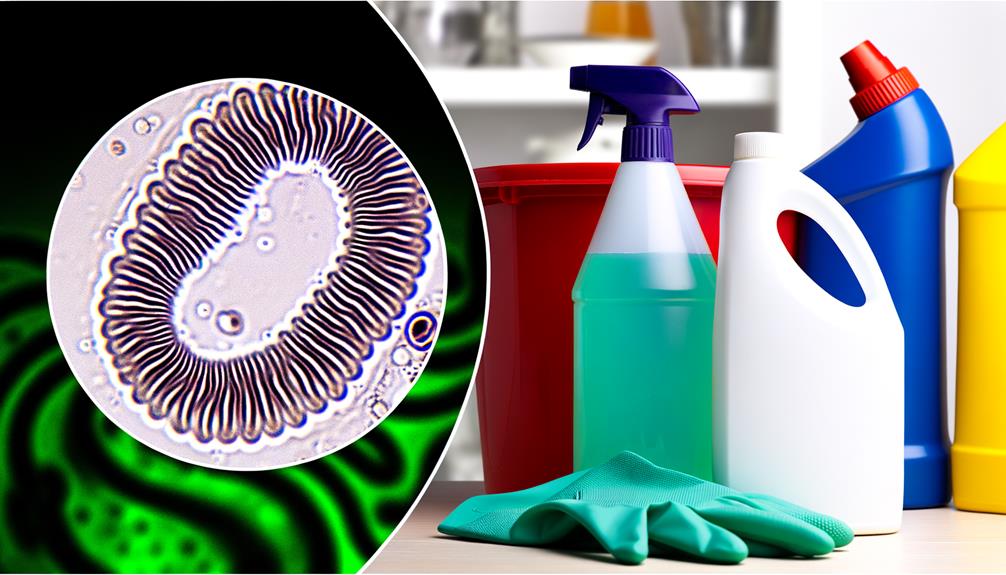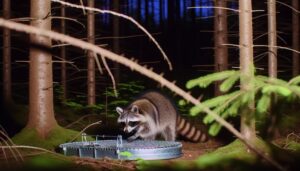Does Bleach Kill Raccoon Roundworm?
Bleach, containing sodium hypochlorite, is a powerful oxidizing agent capable of disrupting the structural integrity of many pathogens. It can break down proteins, lipids, and nucleic acids, making most microorganisms inactive.
However, while bleach is generally effective against microbial pathogens, its effectiveness against raccoon roundworm (Baylisascaris procyonis) eggs specifically is less certain. Parasitic eggs are remarkably resilient and may require higher concentrations and prolonged contact time to make sure complete inactivation.
For thorough solutions and additional preventive methods against this parasitic nematode, further information is important.

Key Takeaways
- Bleach can disrupt cellular structures of many pathogens, including parasites like raccoon roundworm.
- The oxidative degradation by sodium hypochlorite in bleach can render raccoon roundworm eggs nonviable.
- Effective bleach concentration and sufficient contact time are crucial for killing raccoon roundworm eggs.
- Practical application may vary depending on the surface type and environmental conditions.
- Steam cleaning and other disinfectants may also be used alongside bleach for comprehensive control.
Understanding Raccoon Roundworm
Raccoon roundworm, scientifically known as *Baylisascaris procyonis*, is a parasitic nematode that primarily infects raccoons but can also cause severe and sometimes fatal infections in other animals and humans.
This parasite resides in the small intestine of raccoons, where adult worms produce eggs that are excreted in the host's feces. The eggs become infective after a two to four-week embryonation period in the environment.
When ingested by non-raccoon hosts, the larvae hatch and can migrate to various tissues, causing damage. The lifecycle of *B. procyonis* includes both definitive hosts (raccoons) and paratenic hosts, which inadvertently ingest eggs.
Understanding the biology and transmission of *B. procyonis* is essential for managing and preventing potential zoonotic outbreaks.
Health Risks of Infection
Infection with *Baylisascaris procyonis* can lead to severe neurological, ocular, and visceral diseases in humans and other non-raccoon hosts, posing significant health risks. The larvae migrate through tissues, causing extensive damage. Neurologically, this can result in encephalitis and severe brain damage. Ocularly, larvae migration may cause retinal damage and vision loss. Viscerally, organ damage can lead to abdominal pain and other systemic symptoms.
| Disease Type | Symptoms | Potential Outcomes |
|---|---|---|
| Neurological | Encephalitis, ataxia | Severe brain damage |
| Ocular | Retinal damage, vision loss | Permanent blindness |
| Visceral | Abdominal pain, organ damage | Systemic complications |
Prompt diagnosis and treatment are critical to mitigate these severe health impacts, emphasizing the need for heightened awareness and preventive measures.
Common Disinfectants for Parasites
Frequently, healthcare and environmental professionals seek effective disinfectants to combat parasitic threats, including those posed by *Baylisascaris procyonis* eggs.
Various disinfectants have been studied for their efficacy against resilient parasitic eggs, which are known for their robust protective layers. Quaternary ammonium compounds, though effective against many pathogens, often fall short in eradicating these hardy eggs.
Formaldehyde and hydrogen peroxide have been noted for their potential, albeit with safety and handling concerns. Heat treatment, such as steam cleaning, has proven successful in many cases, providing physical denaturation of parasite proteins. However, practical application may be limited by surface types and environmental constraints.
Understanding the specific biochemical vulnerabilities of parasitic eggs is essential in selecting the appropriate disinfectant.
How Bleach Works
Bleach, a solution of sodium hypochlorite, exerts its disinfectant properties through the oxidative degradation of cellular components, effectively disrupting the structural integrity of microorganisms. This oxidative process involves the donation of oxygen atoms, leading to the breakdown of essential cellular structures such as proteins, lipids, and nucleic acids. The resultant chemical reactions render microorganisms nonviable, preventing their replication and survival.
| Component | Degradation Effect |
|---|---|
| Proteins | Denaturation |
| Lipids | Peroxidation |
| Nucleic Acids | Strand Breaks |
| Cell Membranes | Structural Disruption |
| Enzymes | Inactivation |
This table illustrates the various cellular components targeted by bleach and the corresponding degradation effects. Understanding these interactions elucidates bleach's efficacy as a powerful disinfectant.
Scientific Studies on Bleach
Numerous peer-reviewed studies have investigated the antimicrobial efficacy of bleach, focusing on its ability to inactivate a broad spectrum of pathogens, including bacteria, viruses, fungi, and parasites.
Sodium hypochlorite, the active component in bleach, has been shown to disrupt cellular structures and denature proteins, leading to pathogen inactivation. Research demonstrates its effectiveness at various concentrations and contact times, essential parameters for achieving best disinfection.
Specific studies highlight bleach's potency against resilient organisms, such as Clostridium difficile spores and norovirus. However, the efficacy against parasitic ova, including raccoon roundworm (Baylisascaris procyonis), remains less thoroughly examined.
These studies underscore the importance of tailored disinfection protocols to address specific pathogen resilience and the variable efficacy of bleach under different environmental conditions.
Expert Opinions on Bleach
Leading microbiologists and infectious disease specialists emphasize the critical role of bleach in public health due to its broad-spectrum antimicrobial properties. Bleach, or sodium hypochlorite, is renowned for its efficacy in neutralizing a wide array of pathogens, including bacteria, viruses, and fungi.
Experts underscore its utility in disinfection protocols, highlighting its ability to disrupt cellular membranes and denature proteins, ultimately leading to microbial death. However, its effectiveness against specific parasites, such as raccoon roundworm (Baylisascaris procyonis), remains less conclusive.
Current expert consensus suggests that while bleach is potent in many contexts, its impact on the resilient eggs of raccoon roundworm may be limited, necessitating further research to confirm its efficacy in this particular application.
Best Practices for Prevention
To effectively prevent the spread of raccoon roundworm, it is essential to implement rigorous sanitation measures and control strategies aimed at minimizing human and animal exposure to contaminated environments. Key prevention practices include regularly cleaning areas where raccoons are known to frequent, safely disposing of raccoon feces, and using protective gear during cleanup. Additionally, educating the public on the risks associated with raccoon roundworm and encouraging proper hygiene can notably reduce the risk of infection. The following table provides a concise overview of best practices for prevention:
| Prevention Measure | Description | Frequency |
|---|---|---|
| Sanitation | Clean and disinfect contaminated areas | Weekly |
| Protective Gear | Wear gloves and masks during cleanup | As needed |
| Safe Disposal | Use sealed bags for raccoon feces | Immediate |
| Public Education | Inform about risks and proper hygiene practices | Continuous |
Conclusion
Bleach has been demonstrated to be an effective agent in the eradication of raccoon roundworm (Baylisascaris procyonis) due to its potent oxidizing properties. Scientific studies and expert opinions corroborate its efficacy, making it a recommended disinfectant against this parasitic threat.
Like a razor-sharp scalpel excises infected tissue, bleach methodically destroys the parasite's eggs, thereby mitigating associated health risks. Implementing bleach in sanitation protocols is essential for effective prevention and control of raccoon roundworm transmission.






